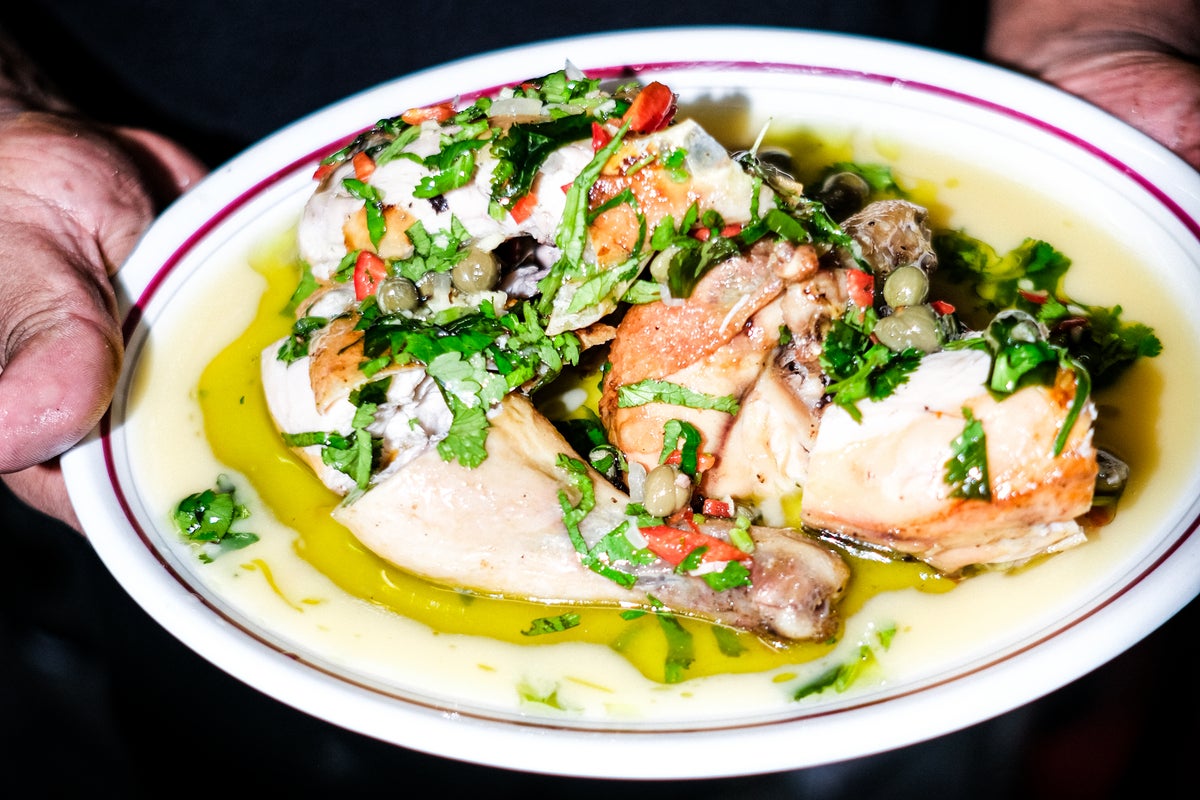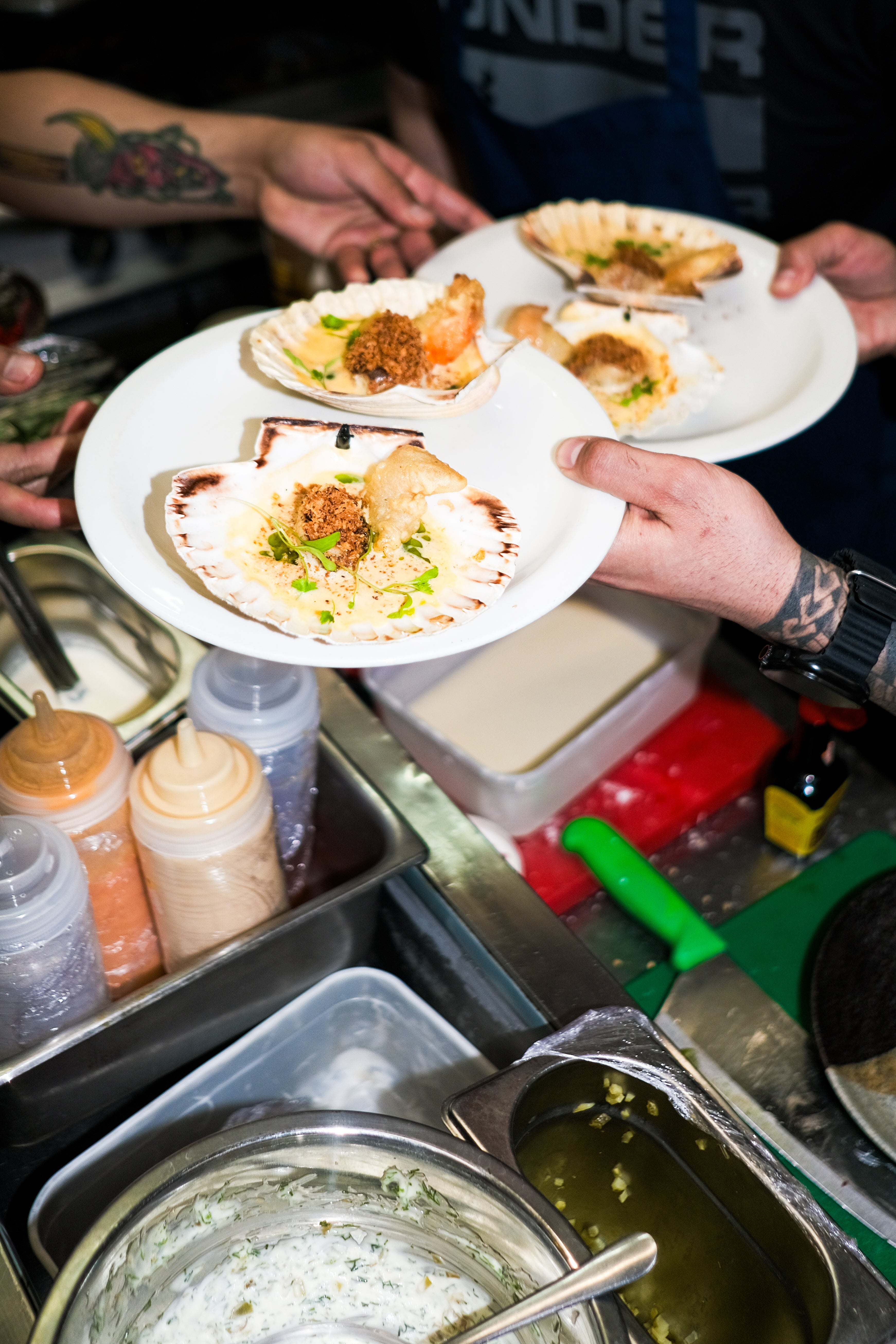
Words like “ube”, “adobo”, and “pandesal” are cropping up on menus with startling frequency. Pret has just launched an ube brûlée iced latte. Filipino recipes are amassing millions of views on TikTok. And for the first time, a modern Filipino restaurant – Donia – has made it into the Michelin Guide. Filipino food is, if not having a full-blown moment, then certainly approaching one.
But for Omar Shah, it’s not a trend. It’s his life.
Shah, the quietly prolific restaurateur behind Ramo Ramen, Mamasons Dirty Ice Cream, Guanabana and now Belly in Kentish Town, has been championing Filipino flavours for well over a decade. His food isn’t defined by strict rules or textbook tradition. Instead, it tells a story – one shaped by his Filipino and Bangladeshi heritage, a childhood spent in a restaurant basement, and a London upbringing where Church Street Market was the local larder.
“I think it was inevitable,” Shah says of Filipino food’s rise. “For a long time, Filipino food was left off the map when it came to Southeast Asian cuisine. That actually worked in our favour when we launched Mamasons – we were the first Filipino ice cream parlour in the UK, serving only Filipino flavours. Back then, the only time I could find ube was once a year at the Filipino festival in Hounslow.”
“Ube really helped put Mamasons on the map – and in turn, Mamasons helped put ube on the map,” he adds. “I mean, how cool is an ice cream made from a vibrant purple yam that also happens to taste amazing? Now we have non-Filipino customers ordering ube as casually as they would vanilla or strawberry. That’s the shift – it’s no longer seen as ‘niche’. It’s just delicious.”
Before we get into lattes and kinilaw sliders, a quick primer. Filipino food is a product of geography, migration and colonisation. The Philippines, a sprawling archipelago of over 7,000 islands, has absorbed centuries of influence – Chinese noodles, Spanish stews, American sweets, Malay curries. Expect vinegar, soy, garlic and sugar, often all at once. Adobo, the national dish, involves meat braised in vinegar and soy. Pancit brings stir-fried noodles; sinigang delivers a tamarind-laced sour soup. It’s comfort food at heart, made for sharing and infinitely adaptable.
Adaptability, in fact, might be Shah’s secret weapon. While the rest of the industry is just catching on, he’s been building restaurants that riff on Filipino flavours for years. And he isn’t bitter about the sudden influx of imitators. Quite the opposite.
“I’m not mad at it,” he says. “As long as it’s done with respect and actually tastes good, I’m all for it. Filipino food is still relatively new to the mainstream, so the more people discover it, the better. Sure, it brings more competition, but that just raises the bar – and in the end, it’s the customers who benefit. That’s always a good thing.”
For Shah, food has always been tied to family. He grew up working at Bintang, his parents’ Kentish Town restaurant. “I loved it – even when I hated it,” he laughs. “At six, my sister and I were folding napkins and helping with cutlery, though we probably caused more mess than anything. After school, we’d go straight to the restaurant. Homework got done on a dining table in the basement, and dinner was always noodles and prawn crackers – our favourite.”
By his teens, he was doing dishes, taking orders, and building a thick skin – “while our friends were out ‘galivanting’, as my mum would say”.
His parents had other plans. “My dad, a Bangladeshi business graduate, never wanted me in hospitality. My Filipina mum hoped I’d be an actor or a singer. I didn’t get the singing gene, but I guess I lived out the theatrics on the restaurant floor – and did the books at the end of the night – so in a way, they both got what they wanted.”

He studied business finance and became an accountant, all the while imagining the kind of restaurant he would open if he could. “I told myself there was no way I’d ever open a restaurant... and yet, I couldn’t stop thinking about it. What I’d serve, how I’d decorate, what kind of space I’d build. The pull never really left.”
Eventually, he gave in. One by one, a mini-empire formed along Kentish Town Road. “I wouldn’t say it was deliberate – though I did learn about monopolies and oligopolies in GCSEs!” he jokes. “I’ve just been in the neighbourhood so long that the landlords know me and my family.”
Historically, he says, “his” stretch of Kentish Town Road was a bit of a dead zone: derelict shops, high turnover, businesses opening and closing within months.
“My parents opened Bingtang here in 1987; I opened Guanabana in 2008 just a few doors down,” he says. After that, “landlords started approaching me when tenants ducked out on the rent or when a space had sat empty for months, sometimes years”.
You always worry. I still worry. You want people to love it, but you quickly learn you can’t please everyone. That said, what’s been 'normal' to me is also normal to a lot of Londoners – multicultural upbringings, shared tables, blended cuisines
It was easy at first: “No rent deposits, generous rent-free periods, handshake deals. The barrier to entry was low. Some spaces even had working kitchens, electric, plumbing, so a lot of the time the heavy lifting was already done.”
His latest, Belly, is the most personal yet. Billed as a modern bistro, it blends wood-fired European technique with unmistakable Filipino flavour: diver scallops cured in malt vinegar and fermented shrimp coconut sauce, oak-smoked tinola chicken, wagyu picanha with liver sauce. There’s a coconut pie with Chantilly cream and, more unexpectedly, a frozen custard profiterole drizzled with fish sauce caramel.
Shah isn’t chasing authenticity for its own sake. “One of my main principles? Don’t give the aunties a reason to come for you,” he says. “There are more versions of adobo than there are islands in the Philippines – everyone thinks theirs is the real one. How can you possibly compete with someone’s mum? You can’t. And you shouldn’t try to.”
“For me, it’s not about chasing some fixed idea of ‘authenticity’. It’s about telling my story through food – what I ate growing up in London, how my Filipino and Bangladeshi roots blended at home, the flavours I’m drawn to and the dishes I wish existed when I was younger.”
Shah grew up in a kitchen where adobo and pancit simmered beside curry and dal. “My mum learned to cook Bengali curries because my dad wasn’t the biggest fan of Filipino food – he needed his spice,” he says. “So our kitchen always had both.”
Outside the house, London was just as much of an influence. “We lived on Edgware Road, right in the heart of Church Street Market. From my bedroom window, I could see a sea of fresh produce and food stalls. Our dinners were global – Filipino, Bangladeshi, whatever we fancied that day.”
Left to their own devices while their parents worked, Shah and his sister quickly learned to fend for themselves – albeit with different approaches. “She was happy with instant mash and a knob of butter. Me? I raided the kitchen – Filipino condiments, Bengali spices and whatever looked good at the market – and just started experimenting.”
“I grew up seeing the common threads between cuisines rather than the differences,” he adds. “That perspective still shapes how I cook and the kind of spaces I try to create: warm, layered, a little chaotic – and always full of flavour.”

That kind of upbringing – rooted in improvisation, curiosity and cultural crossover – gave Shah the confidence to trust his instincts, even when they stray from tradition.
But he won’t let the fear of gatekeeping stop him. “Filipino food isn’t a museum – it’s alive, and it evolves with every new generation.”
That ethos shows up on every menu. At Ramo Ramen, there’s chicken sopas ramen, topped with adobo chicken and inspired by his mum’s Filipino macaroni soup. It’s “childhood, culture, and comfort in one bowl”.
Does he still worry whether diners will “get it”? Of course. “You always worry. I still worry. You want people to love it, but you quickly learn you can’t please everyone. That said, what’s been ‘normal’ to me is also normal to a lot of Londoners – multicultural upbringings, shared tables, blended cuisines.”
Misunderstanding, he says, is part of the process. “I actually enjoy explaining things like sweet spaghetti or balut. They spark curiosity and conversation, which is how understanding begins.”
He mentions his daughter, whose background is Jamaican, Trinidadian, Bangladeshi and Filipino, a true reflection of London’s cultural mash-up. When she visited the Philippines, “watching her try new dishes, ask questions and embrace the unfamiliar reminded me how powerful food can be as a bridge between cultures and identities. Now she’s the one asking for rice for breakfast, lunch, and dinner.”
So what would he like to see change in how British diners approach Filipino food?
“Honestly?” he shrugs. “Nothing. People can approach it however they like — as long as they’re respectful. They don’t even have to like it.”
The unfamiliar, he says, can provoke strong reactions — confusion, hesitation, even discomfort. He remembers trying jellied eels for the first time: “I pulled a face that was probably a bit rude.” Now? “It’s my go-to whenever I’m near a proper pie and mash shop.”
“Taste evolves. Curiosity grows. All I ask is that people stay open-minded — because that’s usually where the good stuff begins.”
And maybe that’s all Filipino food has ever needed: an open mind, a bit of curiosity and someone like Shah serving it with conviction long before anyone else thought to call it a trend.







